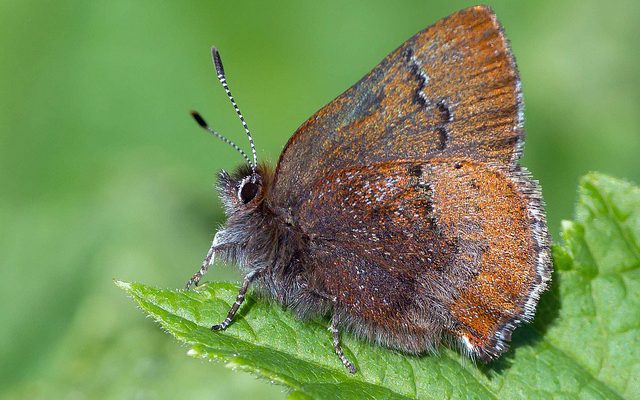
Callophrys mossii bayensis
Callophrys mossii bayensis NatureServe Explorer Species Reports — NatureServe Explorer is a source for authoritative conservation information on more than 50,000 plants, animals and ecological communtities of the U.S and Canada. NatureServe Explorer provides in-depth information on rare and endangered species, but includes common plants and animals too. NatureServe Explorer is a product of NatureServe in collaboration with the Natural Heritage Network.
ITIS Reports — ITIS (the Integrated Taxonomic Information System) is a source for authoritative taxonomic information on plants, animals, fungi, and microbes of North America and the world.
FWS Digital Media Library — The U.S. Fish and Wildlife Service’s National Digital Library is a searchable collection of selected images, historical artifacts, audio clips, publications, and video.Callophrys mossii bayensis R.Brown, 1969 Common names San Bruno elfin Butterfly in English Bibliographic References. Pelham, Jonathan P., 2008: A catalogue of the butterflies of the United States and Canada with a complete bibliography of the descriptive and systematic literature. Journal
Adults of this butterfly emerge in February and March, when nectar providing flowers open. After mating, the female locates host plants on which to deposit her eggs, which hatch within a week. The tiny larvae first feed on the plant’s vegetative structures; however, when the stonecrop‘s flowers begin to open, the larvae migrate upward and feed on the flowers themselves. By June most have completed their larval development at which time they evacuate from the host plant to pupate in ground litter. They lie dormant as pupae until the following spring, when the life cycle begins anew.
The San Bruno elfin’s life cycle holds an interesting aspect, common to many other lycaenids regarding a symbiotic interaction with ants. Elfin larvae excrete a sweet liquid known as honeydew which attracts ants. In exchange for honeydew, the ants often provide protection from harm by predators and parasites, which are principal killers of foliage feeding insects.
| Status | Date Listed | Lead Region | Where Listed |
|---|---|---|---|
| Endangered | 06/08/1976 | California/Nevada Region (Region 8) | Wherever found |
- States/US Territories in which the San Bruno Elfin butterfly, Wherever found is known to or is believed to occur: California
- US Counties in which the San Bruno Elfin butterfly, Wherever found is known to or is believed to occur: View All
| 10/10/1984 | Recovery Plan for San Bruno Elfin and Mission Blue Butterflies | View Implementation Progress | Final |
| 10/10/1984 | Recovery Plan for San Bruno Elfin and Mission Blue Butterflies | View Implementation Progress | Final |
| 05/21/2010 | 75 FR 28636 28642 | Initiation of 5-Year Reviews of 34 Species in California and Nevada; Availability of 96 Completed 5-Year Reviews in California and Nevada |
|
| 03/05/2008 | 73 FR 11945 11950 | Initiation of 5-Year Reviews of 58 Species in California and Nevada; Availability of Completed 5-Year Reviews in California, Nevada and Southern Oregon |
|
| 02/16/2010 | San Bruno Elfin Butterfly and Mission Blue Butterfly 5-Year Review |












